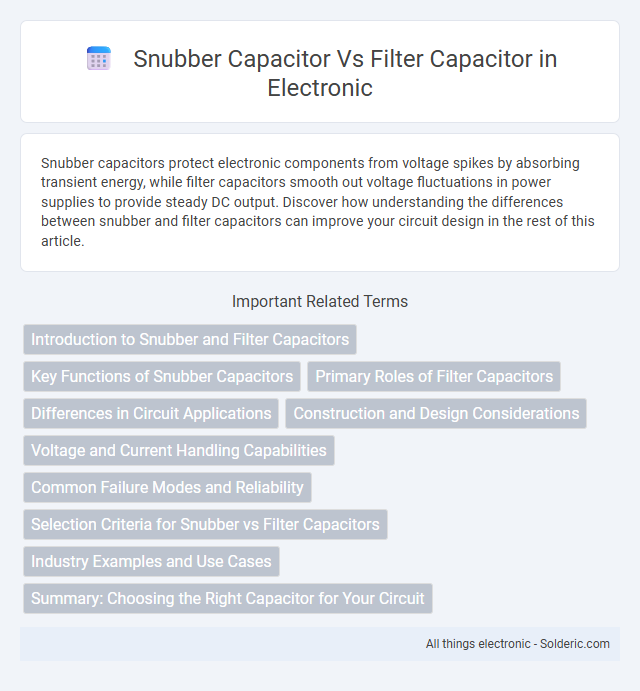Snubber capacitors protect electronic components from voltage spikes by absorbing transient energy, while filter capacitors smooth out voltage fluctuations in power supplies to provide steady DC output. Discover how understanding the differences between snubber and filter capacitors can improve your circuit design in the rest of this article.
Comparison Table
| Feature | Snubber Capacitor | Filter Capacitor |
|---|---|---|
| Primary Function | Absorbs voltage spikes and suppresses transient noise | Smooths and stabilizes DC output voltage by filtering ripple |
| Application | Used in switching circuits, power electronics to protect switches | Used in power supplies, voltage regulators, and audio electronics |
| Capacitance Value | Typically low (pF to nF range) | Higher capacitance (mF to mF range) |
| Voltage Rating | High voltage rating to handle spikes | Moderate voltage rating focusing on steady DC voltage |
| Construction | Often ceramic or film capacitors with low ESR | Electrolytic or film capacitors with higher capacitance |
| Role in Circuit | Protects components from damage by transient voltages | Reduces output voltage ripple and noise |
Introduction to Snubber and Filter Capacitors
Snubber capacitors are designed to suppress voltage spikes and protect semiconductor devices in switching circuits by absorbing transient energy. Filter capacitors smooth out voltage fluctuations and reduce noise in power supplies, ensuring steady DC output by filtering ripple currents. Both play crucial roles in enhancing circuit stability and reliability but target different electrical disturbances.
Key Functions of Snubber Capacitors
Snubber capacitors protect semiconductor devices by suppressing voltage spikes and reducing switching noise in power electronics circuits. They absorb transient energy and prevent damage from voltage surges, enhancing circuit reliability and longevity. Unlike filter capacitors that smooth output voltage ripples, snubber capacitors specifically mitigate high-frequency oscillations during switching events.
Primary Roles of Filter Capacitors
Filter capacitors primarily smooth out voltage by reducing the ripple in power supplies, ensuring a stable DC output essential for sensitive electronic devices. They store and release energy during load variations to maintain consistent voltage levels, which protects your components from fluctuations. Unlike snubber capacitors that suppress voltage spikes and transient noise, filter capacitors excel in steady-state ripple reduction and voltage regulation.
Differences in Circuit Applications
Snubber capacitors are primarily used in power electronics circuits to suppress voltage spikes and reduce switching transients across semiconductor devices, enhancing durability and performance. Filter capacitors, by contrast, are applied in power supply circuits to smooth out voltage and reduce ripple, ensuring a stable DC output. The snubber capacitor's role centers on transient protection while the filter capacitor focuses on steady-state voltage regulation.
Construction and Design Considerations
Snubber capacitors are designed with high pulse current capability and low inductance, often utilizing metalized film or ceramic materials to withstand fast transient voltages and suppress voltage spikes in switching circuits. Filter capacitors typically feature larger capacitance values with electrolytic or film dielectric construction aimed at smoothing continuous DC ripple by storing and releasing charge over longer periods. Design considerations for snubber capacitors prioritize fast response, low equivalent series resistance (ESR), and thermal stability, while filter capacitors emphasize capacitance density, voltage rating, and minimal leakage current for effective noise reduction in power supplies.
Voltage and Current Handling Capabilities
Snubber capacitors are designed to handle high transient voltages and rapid current spikes, providing protection against voltage surges and switching noise in power electronics circuits. Filter capacitors, on the other hand, are optimized for steady-state voltage smoothing and continuous current filtering, managing ripple currents in power supplies and audio equipment. The voltage rating of snubber capacitors typically exceeds that of filter capacitors to accommodate transient overvoltages, while filter capacitors emphasize higher capacitance values for effective noise reduction and current stability.
Common Failure Modes and Reliability
Snubber capacitors commonly fail due to dielectric breakdown and thermal stress from high-voltage transients, reducing their reliability in protecting switching devices. Filter capacitors often experience failure through electrolyte drying, leakage, and capacitance loss, which impacts their ability to smooth voltage fluctuations over time. Proper selection based on application stress and quality ratings is crucial to ensure long-term performance and reliability of both snubber and filter capacitors.
Selection Criteria for Snubber vs Filter Capacitors
Selection criteria for snubber capacitors prioritize high-frequency transient suppression, low equivalent series resistance (ESR), and fast response to protect semiconductor devices from voltage spikes. Filter capacitor selection focuses on energy storage capacity, ripple current handling, low ESR, and dielectric stability to smooth out voltage fluctuations in power supplies. Your choice depends on circuit requirements: snubbers emphasize transient absorption efficiency, while filter capacitors optimize steady-state voltage filtering and ripple reduction.
Industry Examples and Use Cases
Snubber capacitors are widely used in power electronics industries, such as automotive and industrial motor drives, to suppress voltage spikes and protect semiconductor devices like IGBTs and MOSFETs from transient overvoltages. Filter capacitors find extensive application in consumer electronics and renewable energy systems, smoothing output signals in power supplies and reducing electromagnetic interference in photovoltaic inverters. In electric vehicle charging stations, snubber capacitors ensure circuit reliability by damping switching transients, while filter capacitors maintain stable power delivery and enhance overall system efficiency.
Summary: Choosing the Right Capacitor for Your Circuit
Snubber capacitors are designed to suppress voltage spikes and protect semiconductor devices by absorbing transient energy, typically featuring low inductance and high-frequency response. Filter capacitors smooth out voltage fluctuations in power supplies by storing and releasing energy to stabilize DC output, characterized by higher capacitance and low equivalent series resistance (ESR). Selecting the right capacitor depends on circuit requirements: snubbers prioritize transient suppression in switching applications, while filter capacitors focus on reducing ripple in power conversion systems.
Snubber capacitor vs filter capacitor Infographic

 solderic.com
solderic.com